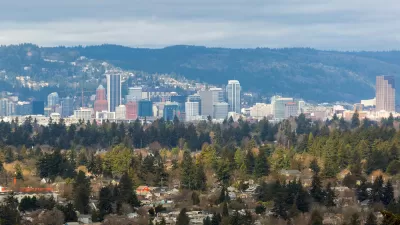Portland wants to add density but doesn't want to displace current residents of low- and middle-income neighborhoods.

Portland's Residential Infill Project, which would allow duplexes, triplexes, and fourplexes in neighborhoods that previously only allowed single-family detached homes, is evolving.
Eliot Njus explains recent changes made to the proposed plan:
Portland is packaging its plan for more density in single-family neighborhoods with a broad proposal to prevent displacement of low-income renters and minority groups, including such things as affordable homeownership programs and stronger tenant protections.
The effort is intended to assuage concerns about the city’s Residential Infill Project, which would allow duplexes, triplexes and four-plexes in neighborhoods traditionally reserved for single-family houses. Critics say the infill project would encourage development that could push out longtime residents.
The effort in Portland mirrors a recent comprehensive plan approved in Minneapolis in its allowance for multiple units on parcels in single-family neighborhoods. The plan has also been characterized in the past as a measure to control the proliferation of McMansions, similar to a law under consideration in Seattle.
The state of Oregon also approved a law banning single-family zoning earlier this year. Njus explains how the new state law affects the process of writing this new local law:
The Residential Infill Project has been in the works for more than four years, but the landscape changed this summer when the Legislature approved House Bill 2001, which requires major cities to allow up to four units per lot in most single-family neighborhoods. The city proposal would largely meet the requirements of the new law, but some tweaks will be needed.
For more background on the Residential Infill Project, see also articles from November 2016 and March 2019 that cast doubt into the effectiveness of the changes proposed by the Residential Infill Project.
FULL STORY: Portland seeks to address worries about infill housing plan with anti-displacement push

Planetizen Federal Action Tracker
A weekly monitor of how Trump’s orders and actions are impacting planners and planning in America.

Maui's Vacation Rental Debate Turns Ugly
Verbal attacks, misinformation campaigns and fistfights plague a high-stakes debate to convert thousands of vacation rentals into long-term housing.

San Francisco Suspends Traffic Calming Amidst Record Deaths
Citing “a challenging fiscal landscape,” the city will cease the program on the heels of 42 traffic deaths, including 24 pedestrians.

Amtrak Rolls Out New Orleans to Alabama “Mardi Gras” Train
The new service will operate morning and evening departures between Mobile and New Orleans.

The Subversive Car-Free Guide to Trump's Great American Road Trip
Car-free ways to access Chicagoland’s best tourist attractions.

San Antonio and Austin are Fusing Into one Massive Megaregion
The region spanning the two central Texas cities is growing fast, posing challenges for local infrastructure and water supplies.
Urban Design for Planners 1: Software Tools
This six-course series explores essential urban design concepts using open source software and equips planners with the tools they need to participate fully in the urban design process.
Planning for Universal Design
Learn the tools for implementing Universal Design in planning regulations.
Heyer Gruel & Associates PA
JM Goldson LLC
Custer County Colorado
City of Camden Redevelopment Agency
City of Astoria
Transportation Research & Education Center (TREC) at Portland State University
Jefferson Parish Government
Camden Redevelopment Agency
City of Claremont





























